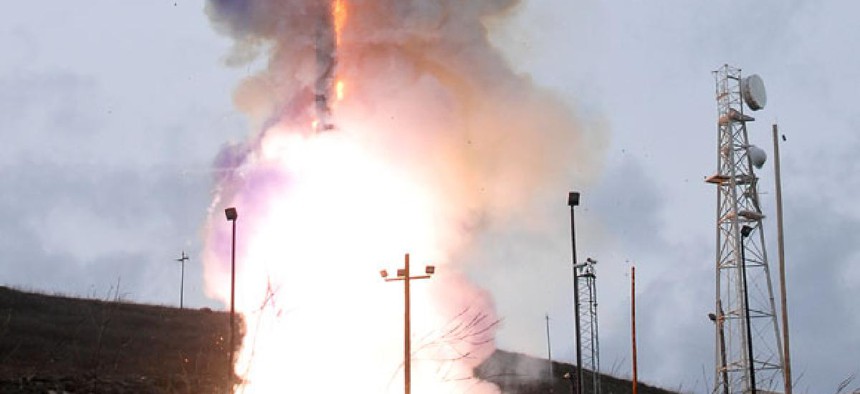Defense Department: Antimissile system held back by kill vehicle

Missile Defense Agency
The ground-based Midcourse Defense system has not had a successful test intercept since 2008.
The United States’ principal homeland missile defense program against a feared long-range attack by North Korea or Iran made little demonstrable headway last year in moving beyond a restricted capacity to defeat a small-scale threat, according to a new Pentagon report.
The Ground-based Midcourse Defense system has not had a successful test intercept since 2008. The last two attempts in 2010 both failed, with the most recent effort breaking down due to a malfunctioning hit-to-kill vehicle.
It took the Missile Defense Agency two years to ascertain exactly why the system’s Exoatmospheric Kill Vehicle was unable to destroy the dummy missile target; develop fixes for the problem; put in place more rigorous requirements for contractors manufacturing EKV components; and to test the redesigned parts.
The Defense Department’s Director, Operational, Test and Evaluation assessment for fiscal 2012 found that while the cause of the previous test failure had been identified and solved, a live space intercept test was needed to confirm the problem had been truly resolved.
Missile Defense Agency spokesman Richard Lehner on Wednesday said no flight tests were conducted in 2012 “because we were working on fixing the component.”
The problem with the kill vehicle was caused by dynamic environments that occur only in space and was identified following extended modeling and ground testing, according to previous statements from the Pentagon branch.
Now that the problem has been solved a fresh flight test is likely to happen in the “near future,” Lehner said in an interview, without offering a specific timeline. It would involve launching a GBI interceptor equipped with the improved hit-to-kill vehicle for the purpose of seeing how the vehicle fixes perform in space.
If that trial goes smoothly, a followup flight intercept test is planned for sometime between April and June, according to Lehner.
There are 30 Ground-based Interceptors in the GMD system spread out in silos at bases in California and Alaska. The long-range antimissile system was created to protect the homeland United States from intermediate-range and intercontinental ballistic missile strikes.
The Exoatmospheric Kill Vehicle is central to the GMD system’s Ground-based Interceptor. It is designed to destroy incoming missiles during the midcourse phase of their flight in space. The technology has been successfully used in eight out of 15 GBI test intercepts to date.
The DOD test and evaluation report found the Missile Defense Agency in 2012 did make headway in returning to GMD interception testing after solving the EKV problem "by conducting a ground test campaign consisting of 11 electrical and mechanical tests designed to further characterize [Capability Enhancement II] kill vehicle component capability and performance."
Despite that, the GMD system continues after years of development efforts to only have a “limited capability” to destroy a small-scale missile threat to the United States. Intercept tests to date have involved only one target, while there are plans to move up to two targets at at some point.
Annual DOT&E reports going back to 2004 have not found any significant advancement in the Ground-based Midcourse Defense system’s “demonstrated limited capacity against a simple [foreign] threat,” according to Kingston Reif of the Center for Arms Control and Nonproliferation, who documented the issue in a Monday post on the Nukes of Hazard blog.
The United States still has some time to improve the GMD system against its intended targets. Though North Korea demonstrated for the first time last month the ability to fire a ballistic missile with a sufficient reach to strike the West Coast, it must still develop a re-entry vehicle, and prove the capability through multiple successful test-firings before it can be said to be a credible strategic missile threat to the United States.
Likewise, Iran is not currently assessed by Congress’ research arm to be aggressively advancing its long-range ballistic missile program. A December report by the Congressional Research Service found it was doubtful Iran would have an ICBM capability before 2016.
Lehner pointed out the GMD system was only intended against lower-level missile threats and not the more robust ICBM programs of Russia and China. That means that while MDA officials will work on taking the antimissile program from a “limited capability” to a robust one, it will still be focused only on defending against the “technology we see from a country like North Korea or Iran.”
“After we have the intercept test [this year], we’ll move along and if the advanced kill vehicle works as it should we will continue our testing program of having a test [every year],” Lehner said.
CORRECTION: An earlier version of this article incorrectly stated the number and type of trials slated for this year for the Ground-based Midcourse Defense system. One flight test and one flight intercept test are planned. The article also misstated the number of successful intercepts of the GMD system using the Exoatmospheric Kill Vehicle. There have been a total of eight.
NEXT STORY: Analytics: Big data takes center stage in 2013



